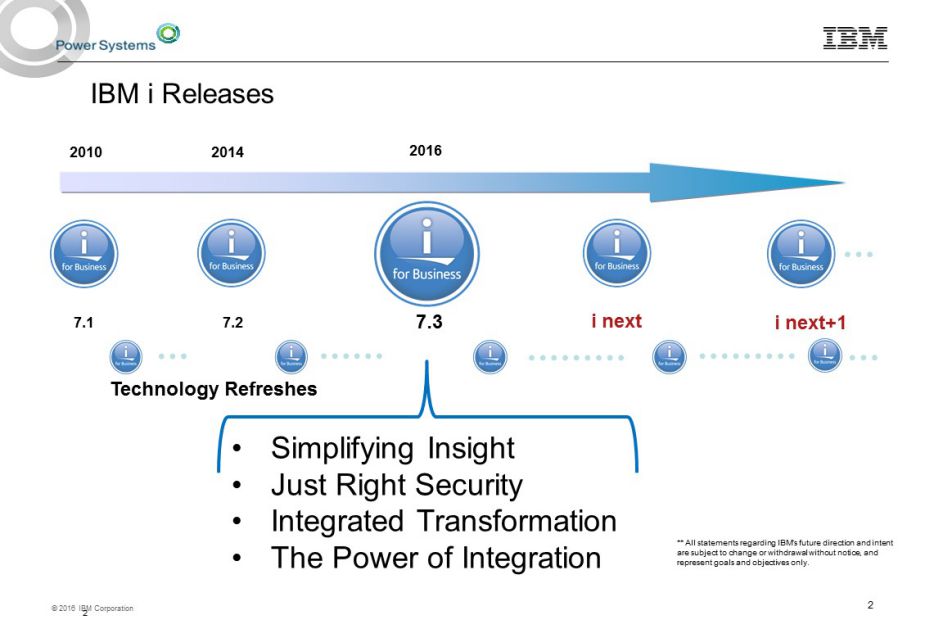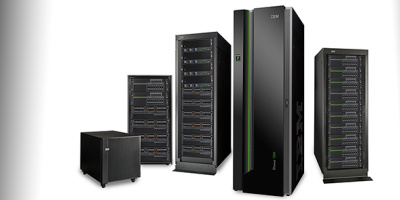Accompany an apprentice wizard on this tour of IBM i 7.3 and avoid being whomped by a willow or suffer from petrification.
Recently, my wizarding powers were revealed, and I joined a small group of muggles who had special powers. While this may seem neither newsworthy nor consequential to you, the timing of this development couldn't be more fortunate. To develop my skills, I must follow the wizarding training protocol. If this sounds confusing, don't despair. After all, you're not a wizard, are you? I'm required to practice and demonstrate various spells and charms. I've visited Ollivander's and had a wand choose me, and I'm ready to commence my journey.
Where should I start? With the release of IBM i 7.3, I will attempt to master the Lumos Maxima charm, shining a bright light over the most impressive improvements of IBM i's latest operating system release.
This "IBM i 7.3 Illumination series" will appear in the coming weeks and months. Each installment will focus on a specific topic of something new in IBM i 7.3.
While you can spend your days and nights reading updated IBM Knowledge Center books or IBM i Technology Updates wiki pages and find some of these details on your own, I invite you to join me on my wizarding quest. For those who need the full details immediately, I suggest you examine these IBM i enhancement landing pages:
- http://www.ibm.com/developerworks/ibmi/techupdates/i72-TR4
- http://www.ibm.com/developerworks/ibmi/techupdates/i73
Figure 1 shows the IBM i release timeline and begins to shine light on what's included in IBM i 7.3. As the figure shows, the number of years between IBM i releases can vary. We're delighted that 7.3 came out only two years after 7.2, because it contains lots of features that we believe will resonate with our clients.

Figure 1: This is the IBM i release timeline.
What should you expect in the future? I haven't reached the fortune teller wizarding level yet, so I'll keep you focused on the task at hand: understand the unique value of IBM i 7.3. Your task is to determine where this release can best fit into your plans.
What's New or Improved with IBM i 7.3
While there's a long list of enhancements, I will keep my wand pointed toward the database side of the castle. When a new operating system release occurs, the IBM i development team looks hard at the limitations in the operating system and makes infrastructure changes to permit customers to grow and scale their operations well into the future. IBM i 7.3 includes some noteworthy architectural extensions.

Figure 2: Architectural limits are extended on IBM i 7.3.
First, the maximum number of objects within a library has nearly tripled to one million. If you're wondering whether we used an IBM i version of the Engorgement Charm, you would be correct! This is the sort of change that would not be tenable via PTFs. Changes were required over many parts of the operating system to account for the higher limit. What do you have to do to use this enhancement? Simply upgrade to IBM i 7.3, and your existing and future libraries will be Engorgio-enabled.
A side note on this improvement is that IBM i System Health Services can be used to monitor your high point consumption for this and other important IBM i architectural limits. The SQL statement found below can be executed on IBM i 7.1 and up. Like most health-related information, it can only be of benefit if you regularly review it.
Why does the query include an examination of the QSYS library? Even though QSYS contains many operating system objects, it also contains user-initiated objects like libraries and user profiles.
-- Description: Examine the top consumption of the limit:
-- "Maximum number of object description entries in a library"
-- returning the top 3 consumption points for each library
WITH LIBRARY_OBJECTS(SYSTEM_OBJECT_NAME, USER_NAME, CURRENT_VALUE, MAXIMUM_VALUE, WHEN, NUM)
AS (SELECT SYSTEM_OBJECT_NAME, USER_NAME, CURRENT_VALUE,
MAXIMUM_VALUE, LAST_CHANGE_TIMESTAMP, ROW_NUMBER()
OVER(PARTITION BY SYSTEM_OBJECT_NAME
ORDER BY CURRENT_VALUE DESC)
FROM QSYS2.SYSLIMITS
WHERE LIMIT_ID = 18400 AND
(SYSTEM_OBJECT_NAME = 'QSYS' OR
SYSTEM_OBJECT_NAME NOT LIKE 'Q%'))
SELECT SYSTEM_OBJECT_NAME, USER_NAME, CURRENT_VALUE,
MAXIMUM_VALUE, NUM, WHEN
FROM LIBRARY_OBJECTS
WHERE NUM < 4 ORDER BY CURRENT_VALUE DESC;
The other instances of raised limits are squarely focused on DB2 for i users (which is 100 percent of you, by the way). User-Defined Table Functions (UDTFs) have jumped onto a broom and zoomed into the forefront of database application development. Why? Because they're powerful, extensible, flexible, and standards-based. I'm sure I'm leaving out some superlatives in this list. The additional head room for larger numbers of parameters and return columns keeps you from hitting your head on something hard.
Till Next Time…
Did you wonder whether I had visited the Sorting Hat? My soul and psyche were laid bare to the probing and insightful Sorting Hat, and my destiny has been settled. I will become a member of... WAIT! You'll need to read the next installment of the "i Illuminate 7.3" series to learn the answer. Stay tuned.





















 More than ever, there is a demand for IT to deliver innovation. Your IBM i has been an essential part of your business operations for years. However, your organization may struggle to maintain the current system and implement new projects. The thousands of customers we've worked with and surveyed state that expectations regarding the digital footprint and vision of the company are not aligned with the current IT environment.
More than ever, there is a demand for IT to deliver innovation. Your IBM i has been an essential part of your business operations for years. However, your organization may struggle to maintain the current system and implement new projects. The thousands of customers we've worked with and surveyed state that expectations regarding the digital footprint and vision of the company are not aligned with the current IT environment. TRY the one package that solves all your document design and printing challenges on all your platforms. Produce bar code labels, electronic forms, ad hoc reports, and RFID tags – without programming! MarkMagic is the only document design and print solution that combines report writing, WYSIWYG label and forms design, and conditional printing in one integrated product. Make sure your data survives when catastrophe hits. Request your trial now! Request Now.
TRY the one package that solves all your document design and printing challenges on all your platforms. Produce bar code labels, electronic forms, ad hoc reports, and RFID tags – without programming! MarkMagic is the only document design and print solution that combines report writing, WYSIWYG label and forms design, and conditional printing in one integrated product. Make sure your data survives when catastrophe hits. Request your trial now! Request Now. Forms of ransomware has been around for over 30 years, and with more and more organizations suffering attacks each year, it continues to endure. What has made ransomware such a durable threat and what is the best way to combat it? In order to prevent ransomware, organizations must first understand how it works.
Forms of ransomware has been around for over 30 years, and with more and more organizations suffering attacks each year, it continues to endure. What has made ransomware such a durable threat and what is the best way to combat it? In order to prevent ransomware, organizations must first understand how it works. Disaster protection is vital to every business. Yet, it often consists of patched together procedures that are prone to error. From automatic backups to data encryption to media management, Robot automates the routine (yet often complex) tasks of iSeries backup and recovery, saving you time and money and making the process safer and more reliable. Automate your backups with the Robot Backup and Recovery Solution. Key features include:
Disaster protection is vital to every business. Yet, it often consists of patched together procedures that are prone to error. From automatic backups to data encryption to media management, Robot automates the routine (yet often complex) tasks of iSeries backup and recovery, saving you time and money and making the process safer and more reliable. Automate your backups with the Robot Backup and Recovery Solution. Key features include: Business users want new applications now. Market and regulatory pressures require faster application updates and delivery into production. Your IBM i developers may be approaching retirement, and you see no sure way to fill their positions with experienced developers. In addition, you may be caught between maintaining your existing applications and the uncertainty of moving to something new.
Business users want new applications now. Market and regulatory pressures require faster application updates and delivery into production. Your IBM i developers may be approaching retirement, and you see no sure way to fill their positions with experienced developers. In addition, you may be caught between maintaining your existing applications and the uncertainty of moving to something new. IT managers hoping to find new IBM i talent are discovering that the pool of experienced RPG programmers and operators or administrators with intimate knowledge of the operating system and the applications that run on it is small. This begs the question: How will you manage the platform that supports such a big part of your business? This guide offers strategies and software suggestions to help you plan IT staffing and resources and smooth the transition after your AS/400 talent retires. Read on to learn:
IT managers hoping to find new IBM i talent are discovering that the pool of experienced RPG programmers and operators or administrators with intimate knowledge of the operating system and the applications that run on it is small. This begs the question: How will you manage the platform that supports such a big part of your business? This guide offers strategies and software suggestions to help you plan IT staffing and resources and smooth the transition after your AS/400 talent retires. Read on to learn:
LATEST COMMENTS
MC Press Online